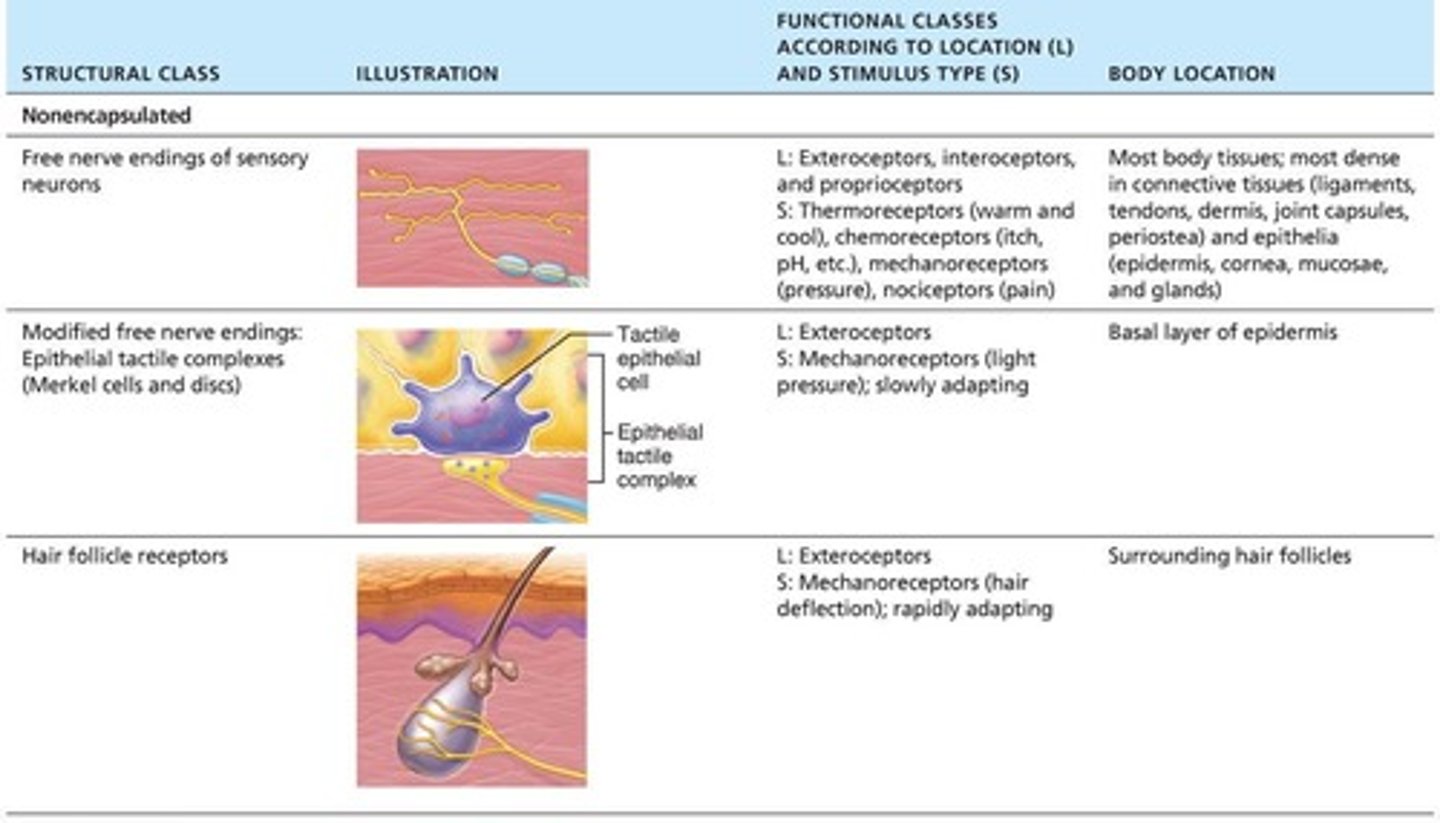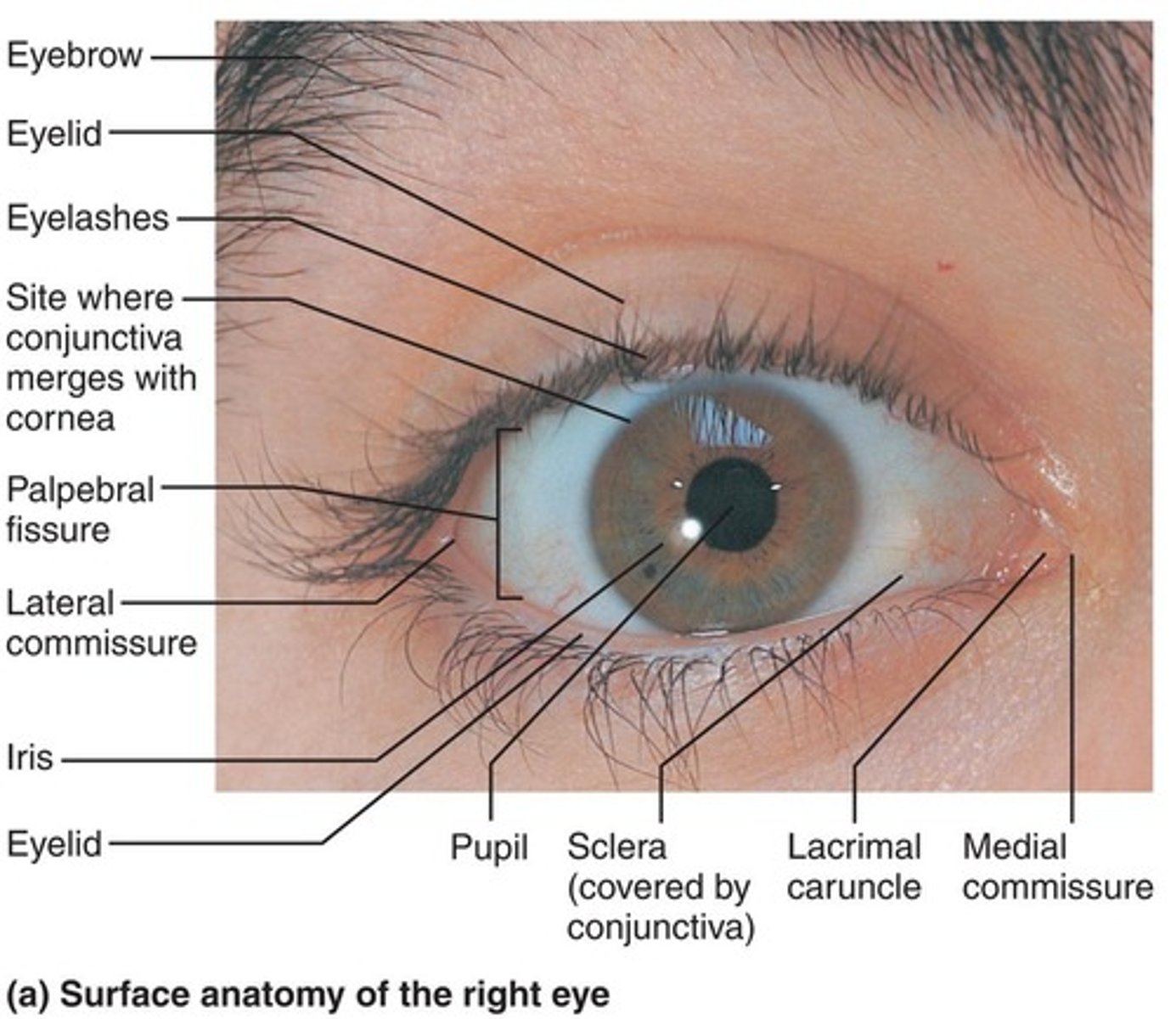Anatomy & Physiology: Peripheral Nervous System and Sensory Receptors
1/48
There's no tags or description
Looks like no tags are added yet.
Name | Mastery | Learn | Test | Matching | Spaced |
|---|
No study sessions yet.
49 Terms
What does the Peripheral Nervous System (PNS) provide?
Links from and to the world outside our body.
What are the four parts of the PNS?
1. Sensory Receptors and Sensation 2. Transmission Lines: Nerves and Their Structure and Repair 3. Motor Endings and Motor Activity 4. Reflex Activity

What is the difference between sensation and perception?
Sensation is awareness of stimulus changes, while perception is the interpretation of the meaning of the stimulus.
What is the somatosensory system?
Part of the sensory system serving the body wall and limbs, receiving inputs from exteroceptors, proprioceptors, and interoceptors.
What are the three levels of neural integration in sensory systems?
1. Receptor level 2. Circuit level 3. Perceptual level
What must occur for sensation to happen at the receptor level?
The stimulus must excite a receptor, and the action potential must reach the CNS.
What is transduction in sensory processing?
The conversion of stimulus energy into graded potentials, either generator potential (general receptors) or receptor potential (special sense receptors).
What is adaptation in sensory receptors?
A change in sensitivity in the presence of a constant stimulus, where receptor potentials decline in frequency or stop.
What are phasic receptors?
Fast-adapting receptors that send signals at the beginning or end of a stimulus, such as those for pressure and touch.
What are tonic receptors?
Receptors that adapt slowly or not at all, such as nociceptors and most proprioceptors.
What is the role of first-order sensory neurons?
They conduct impulses from the receptor level to spinal reflexes or second-order neurons in the CNS.
What is the function of third-order sensory neurons?
They conduct impulses to the cerebral cortex, representing the perceptual level of processing.
What is perceptual detection?
The ability to detect a stimulus, which requires the summation of impulses.
What is spatial discrimination in sensory perception?
The ability to identify the site or pattern of a stimulus, often tested by the two-point discrimination test.
What is feature abstraction in sensory processing?
The identification of more complex aspects and several properties of a stimulus.
What is quality discrimination?
The ability to identify submodalities of a sensation, such as distinguishing between sweet and sour tastes.
What is pattern recognition in sensory perception?
The recognition of familiar or significant patterns in stimuli, such as melodies in music.
What is the purpose of pain perception?
To warn of actual or impending tissue damage so protective action can be taken.
What stimuli can activate pain receptors?
Extreme pressure, temperature, histamine, K+, ATP, acids, and bradykinin.
What neurotransmitters are released during pain impulses?
Glutamate and substance P.
What is pain tolerance?
The variation in the perception of pain at the same stimulus intensity, influenced by genetic factors.
What is referred pain?
Pain from one body region perceived as coming from a different region due to shared nerve pathways.
What is phantom limb pain?
Pain felt in a limb that has been amputated, often managed with epidural anesthesia during surgery.
What can long-lasting or intense pain lead to?
Hyperalgesia (pain amplification), chronic pain, and phantom limb pain.
What are sensory receptors specialized to respond to?
Changes in the internal and external environment (stimuli).
What happens when sensory receptors are activated?
They generate graded potentials that trigger nerve impulses.
Where does awareness of a stimulus and its interpretation occur?
In the brain.
How can sensory receptors be classified?
By type of stimulus, body location, and structural complexity.

What do mechanoreceptors respond to?
Touch, pressure, vibration, and stretch.
What type of stimuli do thermoreceptors detect?
Changes in temperature.
What do photoreceptors respond to?
Light energy, such as that detected by the retina.
What do chemoreceptors respond to?
Chemicals, including those involved in smell and taste.
What are nociceptors sensitive to?
Pain-causing stimuli, such as extreme heat or cold, excessive pressure, and inflammatory chemicals.
What are exteroceptors?
Receptors that respond to stimuli arising outside the body, such as those in the skin for touch, pressure, pain, and temperature.
What do interoceptors (visceroceptors) respond to?
Stimuli arising in internal viscera and blood vessels, sensitive to chemical changes, tissue stretch, and temperature changes.
What do proprioceptors respond to?
Stretch in skeletal muscles, tendons, joints, ligaments, and connective tissues, informing the brain of movements.
What are the two main categories of sensory receptors?
Simple receptors of the general senses and receptors for special senses.
What do simple receptors of the general senses monitor?
Tactile sensations, temperature, pain, and muscle sense.
What are nonencapsulated (free) nerve endings?
Receptors abundant in epithelia and connective tissues that respond mostly to temperature, pain, or light touch.
What activates cold receptors?
Temperatures from 10°C to 40°C, located in the superficial dermis.
What activates heat receptors?
Temperatures from 32°C to 48°C, located in the deeper dermis.
What are epithelial tactile (Merkel) discs?
Light touch receptors located in the deeper layers of the epidermis.
What are tactile (Meissner's) corpuscles?
Small receptors involved in discriminative touch, found just below the skin in sensitive areas.
What do lamellar (Pacinian) corpuscles respond to?
Deep pressure and vibration when first applied.
What is the function of muscle spindles?
They are proprioceptors that respond to muscle stretch.
What is the role of the tendon organ?
Proprioceptors located in tendons that detect stretch.
What percentage of the body's sensory receptors are located in the eye?
Approximately 70%.
What is the primary function of accessory structures of the eye?
To protect the eye and aid in its function.
Name one accessory structure of the eye.
Eyebrows, eyelids, conjunctiva, lacrimal apparatus, or extrinsic eye muscles.
